
|
You entered: Observatory
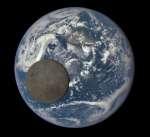 Full Earth, Full Moon
Full Earth, Full Moon
6.08.2015
The Moon was new on July 16. Its familiar nearside facing the surface of planet Earth was in shadow. But on that date a million miles away, the Deep Space Climate Observatory (DSCOVR) spacecraft's Earth Polychromatic Imaging Camera (EPIC) captured this view of an apparently Full Moon crossing in front of a Full Earth.
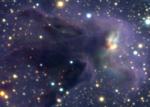 M16: Infrared Star Hunt
M16: Infrared Star Hunt
3.01.2002
The head of an interstellar gas and dust cloud is shown here in false-color, a near-infrared view recorded by astronomers hunting for stars within M16's Eagle Nebula. Made famous in a 1995 Hubble...
 Comet Hyakutake's Closest Approach
Comet Hyakutake's Closest Approach
23.03.1996
The above true color image of Comet Hyakutake was taken the night of March 21/22. Tonight, Comet Hyakutake will make its nearest approach to Earth, closing to a mere 10 million miles as it passes over the planet's Northern Hemisphere.
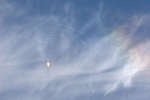 Exceptional Rocket Waves Destroy Sun Dog
Exceptional Rocket Waves Destroy Sun Dog
22.02.2010
What created those rocket waves, and why did they destroy that sun dog? Close inspection of the above image shows not only a rocket rising near the center, but unusual air ripples around it and a colorful sundog to the far right.
 COMPTEL Explores The Radioactive Sky
COMPTEL Explores The Radioactive Sky
24.07.1996
Diffuse gas clouds laced with radioactive aluminum atoms (Al26) line the plane of our Milky Way Galaxy! How do we see them? Relying on the Compton Effect, the COMPTEL instrument onboard NASA's immense orbiting Compton Gamma Ray Observatory can "see" the 1.8 million electron Volt gamma rays emitted by the radioactive decay.
 Red Moon, Green Beam
Red Moon, Green Beam
18.04.2014
This is not a scene from a sci-fi special effects movie. The green beam of light and red lunar disk are real enough, captured in the early morning hours of April 15. Of course, the reddened lunar disk is easy to explain as the image was taken during this week's total lunar eclipse.
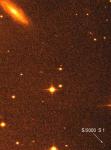 New Moons For Saturn
New Moons For Saturn
2.11.2000
Which planet has the most moons? For now, it's Saturn. Four newly discovered satellites bring the ringed planet's total to twenty-two, just edging out Uranus' twenty-one for the most known moons in the solar system. Of course, the newfound Saturnian satellites are not large and photogenic.
 Aurora Over Antarctica
Aurora Over Antarctica
19.03.2002
Looking out from the bottom of the world, strange and spectacular sights are sometimes observed. Such was the case during the long Antarctic night of 1998, as awesome aurora sub-storms were photographed above scientific outposts. Visible in the left foreground of the above photograph is the Martin A.
 M51: The Whirlpool Galaxy
M51: The Whirlpool Galaxy
24.01.1997
The Whirlpool Galaxy is a classic spiral galaxy. At only 15 million light years distant, M51, also cataloged as NGC 5194, is one of the brighter and more picturesque galaxies on the sky.
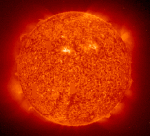 A Winter Solstice
A Winter Solstice
20.12.1997
Today is the Winter Solstice, the shortest day of the year in the Northern Hemisphere. The yearly cycle of Seasons on planet Earth once again finds the Sun at its lowest point in the Northern Sky.
|
January February March April May June July |
|||||||||||||||||||||||||||||||||||||||||||||||||